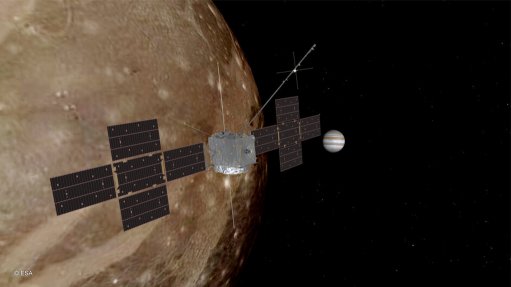
An artist’s impression of JUICE over Ganymede, with Jupiter in the background
Photo by: ESA
The European Space Agency’s (ESA’s) Jupiter Icy moons Explorer (JUICE) spacecraft is now on its way to Jupiter, having successfully deployed its large solar power arrays, following its launch on Friday. JUICE was carried aloft, from “Europe’s Spaceport” at Kourou in (French) Guiana in South America, on Friday, on an Ariane 5 rocket. This was one of the last launches to be performed by an Ariane 5, which is set to be replaced by the new Ariane 6.
Because ESA does not yet have the capability to produce radioisotope thermoelectric generators, which are normally used to power probes sent into the outer solar system (Jupiter and beyond) and which are compact, reliable and provide ample power, JUICE has to use solar power. But sunlight at Jupiter is 25 times weaker than it is at Earth. Consequently, the spacecraft has very large solar arrays, totalling ten panels, each 2.5 m by 3.5 m, arranged in a cross-shape to ensure JUICE’s stability. These panels contain a total of 23 560 solar cells and have a combined area of 85 m2. They are able to withstand intense radiation and endure temperature ranges from +110 °C to –230 °C.
As is normal for outer system spacecraft, to save fuel JUICE will follow an indirect course to Jupiter, using flybys of the Earth, Moon and Venus to get “gravity assists” to accelerate it out to its target. The first fly-by will be of the Earth and Moon (in rapid succession), in August next year. It will then fly-by Venus in August 2025, Earth alone in September 2026, Earth alone again in January 2029, and then arrive at Jupiter in July 2031, after an eight-year voyage, covering five billion kilometres.
The spacecraft’s prime mission is to study Jupiter’s three ice-covered moons, Callisto, Europa and Ganymede, but it will also study Jupiter itself. Callisto, Europa and Ganymede are three of the four moons discovered by renowned Italian astronomer Galileo Galilei when he became the first to train a telescope on Jupiter, in 1610. (The fourth, Io, is rocky and highly volcanic.) Previous space probes established that Callisto, Europa and Ganymede all host, under their thick ice surfaces, volumes of water greater than those in all the Earth’s oceans combined. This water might be contained within icy sludges, but there might be open oceans between the crust and core of one, other, or all three, of these worlds. And the conditions in such oceans might be conducive to life.
JUICE is carrying ten latest-technology scientific instruments, one of them contributed by the US National Aeronautics and Space Administration. The Japanese Aerospace Exploration Agency and the Israel Space Agency contributed parts of other instruments. The spacecraft’s instrument suite includes an ice-penetrating radar, an altimeter, a radio-science experiment, a particle package, spectrometers, cameras, and a range of electric and magnetic field sensors.
When it reaches Jupiter, it will enter orbit around the giant planet and, from 2031 to 2034, carry out 35 fly-bys of the three icy moons. At the end of 2034, it will manoeuvre itself out of orbit of Jupiter and into orbit around Ganymede, which it will closely study, until the end of its mission, about nine months later.